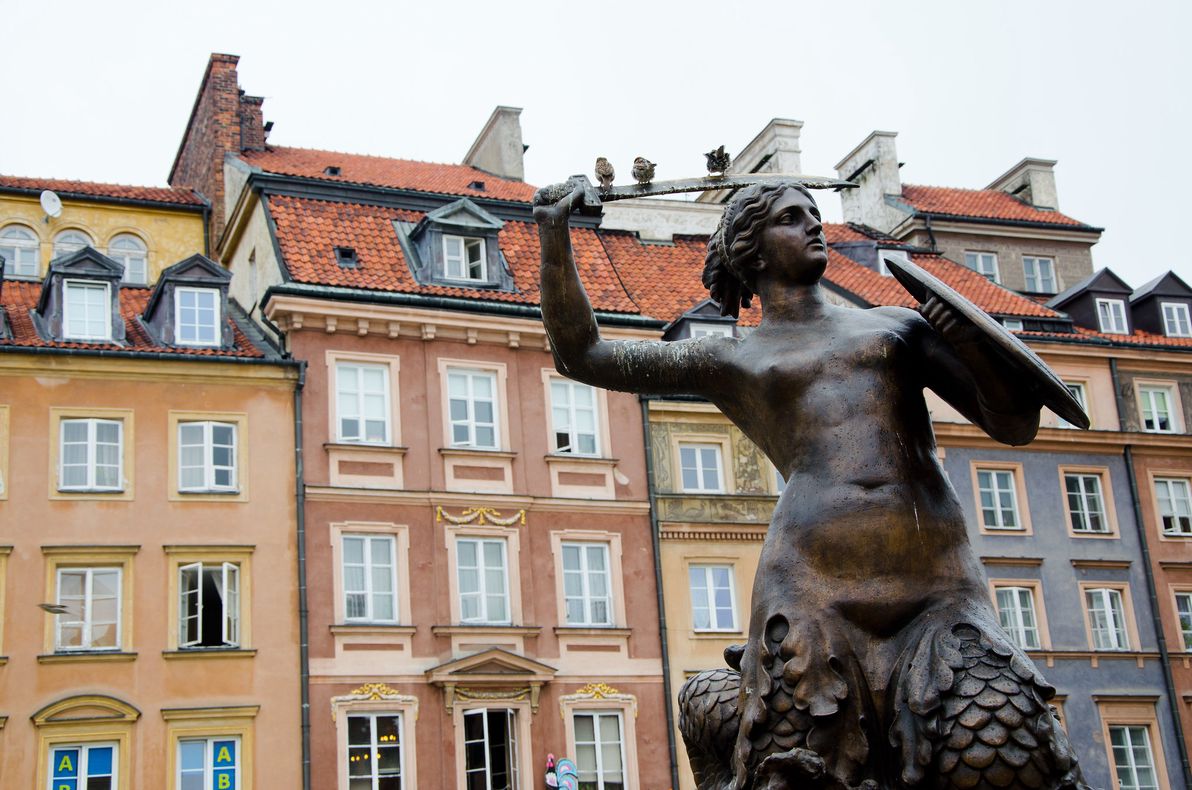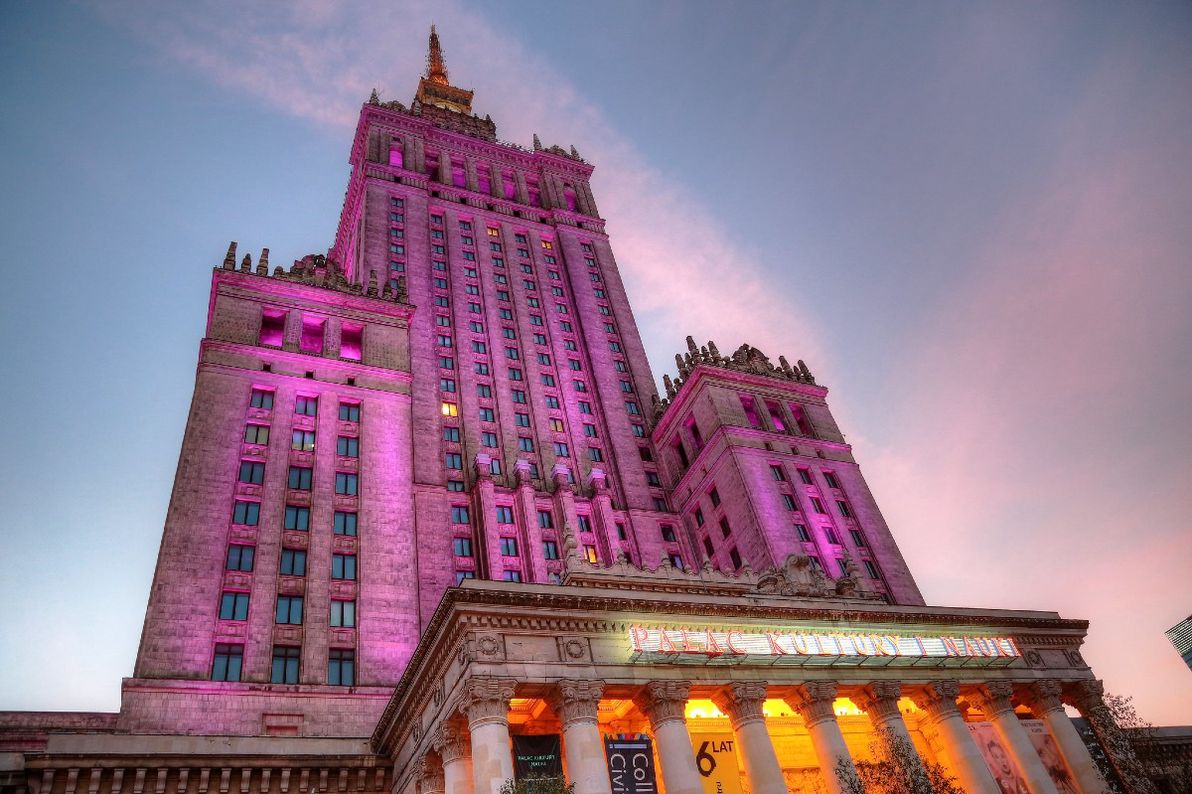Warsaw is a perfect destination for a European weekend city break. From historical landmarks and inspiring museums to traditional Polish restaurants and trendy cafés, here is a guide for spending 48 hours in Warsaw:
Day 1: Historic Warsaw
The Old Town

A window into the ‘once-upon-a-time’ of Warsaw’s golden days, the Old Town represents much more to Warsaw’s citizens than UNESCO accolades, postcard panoramas and tourist dollars. Entirely rebuilt after the Warsaw Uprising of 1944, the Old Town is also symbolic of Warsaw’s rise from the ruins of WWII and of Varsovians’ pride in their city.

Start your visit to Warsaw in the very heart of the city at the Castle Square under King Sigismund’s Column. Walk around the Old Town and absorb the city’s rich culture, with historic churches, statues and monuments all around. Look out for the Mermaid statue in the Market Square, and the Monument to the Little Insurgent in particular! Another must-do is the climb up the St Anne’s Church tower for one of the best views over the city. The 150 steps up is well worth it!
Before leaving the Old Town, make sure to stop by the Barbican with its distinctive red bricks. Built in 1540, this age-old fortress is the second largest in Poland and used to encircle the city.
The Royal Route

Passing through the Barbican, the historic ‘Royal’ route is one of Warsaw’s most famous streets. Stop for lunch along the way at one of the city’s iconic milk bars, such as Bar Mleczny Pod Barbakenem near the Old Town. Alternatively, head to Familijny Bar Mleczny on Nowy Swiat along the route itself. The Royal route is roughly 2km long and takes 30 minutes to walk the entire length. This mostly pedestrian avenue has 2 sections, comprised of the famous Nowy Swiat and Krakowskie Przedmiescie.

En route from Krakowskie Przedmiescie, you can expect to walk past many statues and beautiful buildings. Take note of how the buildings change as you walk away from the Old Town. Some of the more popular sights along the way include the Presidential Palace, the Copernicus Statue, the Tomb of the Unknown Soldier, the University of Warsaw, and Church of the Holy Cross. Spaced out along the Royal way are ‘Chopin benches’, black marble benches that play Chopin’s music, which are an interesting attraction.
Lazienki Park

The Royal route will eventually lead you to Warsaw’s biggest and oldest park, Lazienki Park. Once used as a hunting ground, Lazienki Park is a welcome respite from the hustle and bustle of the city. Beautiful all year round, the park is famous for permanent residents: the peacocks and squirrels. While the park is home to a winter garden, an amphitheatre and even a Chinese garden, its biggest attraction remains the aesthetically-pleasing Palace on the Isle.

The park is famous for its Chopin concerts, which take place from mid-May to the end of September every Sunday at noon and 4 pm. Not to be missed, come lounge on the grass and enjoy the music.
Hala Koszyki

Head to Hala Koszyki for dinner. A 20-minute walk from Lazieki Park, this artfully converted early-20th-century market hall has become the new place to be in Warsaw. Perfect for large groups or indecisive individuals, this market hall is stacked with a wide variety of options from sushi and tapas bars to craft-beer stations and artisan chocolate shops. With a bar as its central element, the venue can easily go from dinner with friends to pre-drinks and fun.
Palace of Culture and Science

The most-visible building in the city, the Palace is to Warsaw what the Eiffel Tower is to Paris. Burn off the calories from dinner over the 13-minute walk to this architectural landmark, which was a gift from Stalin to the Poles. This controversial building strikes differently at night, all lit up against the backdrop of the cityscape.

Take the lift up to the 30th floor to see the city panorama from a height of 114 metres. While beautiful during the day, this view is simply breath-taking once the sun has set and the skyscrapers light up the city’s skyline. The palace also houses theatres, a cinema, museums and trendy bistros, as well as the city’s main tourist information point.
Day 2: Contemporary Warsaw
POLIN Museum

Start your day off at the award-winning POLIN Museum. An absolute must, this museum does what it sets out to do. Built in the heart of the former Jewish Ghetto, the POLIN Museum restores the memory of the rich, thousand-year shared history of two peoples: Poles and Jews.

The interactive exhibition will take you on an incredible journey across centuries. You’ll have the chance to walk the streets of a pre-war Jewish shtetl and discover how Polish and Jewish cultures have intermingled. The edifice of the museum is itself an architectural attraction and poignant reminder of the Jewish story in Warsaw.
Praga

Cross over the Vistula River to the edgy district of Praga. Unlike most of Warsaw, Praga was left relatively unscathed by the war, evidenced by its many old and worn buildings. With its distinctly alternative vibe and keenly independent spirit, Praga almost feels like a different city. There are plenty of quirky cafés and shops to explore, and while it is gritty, it has its own distinctive charm. Grab lunch at Pyzy Flaki Gorace, where authentic Polish food is served in the traditional Varsovian manner in cute mason jars. Serving delicious Warsaw specialties such as tripe (flaki), Pyzy Flaki Gorace arguably serve the best budget meal in Warsaw. This is the essence of Poland served in a jar.

After lunch, explore the streets of Praga and don’t forget to look around and up for the various street art adorning the walls in this neighbourhood. Loaded with relevant messages and subliminal meaning, these powerful works of art reference everything from history and politics to current affairs and Polish cultural heritage and are an intangible part of Warsaw’s heritage.
Neon Museum

Also in the Praga district, the Neon Museum offers an illuminating insight into Poland’s Communist past. Through their collection of Cold War-era neon signage, the museum charts the political post-war progression of Poland – from its rise in the 1950s to the demolition of communism. The museums is also full of photo opportunities with the various neon signs providing the perfect backdrop.
Stroll Along the Vistula

End your trip with a relaxing stroll along the Vistula. No other river in Europe is like the Vistula flowing through Warsaw. Its natural banks, inhabited by wild fowl, are right next to the city’s boulevards. In the summer, the weekend city life comes alive here – trendy bars and clubs, charming bistros, and outdoor events attract both city dwellers and tourists, while the sandy beaches are the perfect place to chill out. During the summer months, Boathouse is a very popular spot for dinner located along the river bank. Otherwise, head to the famous Zapiecek for their famour pierogi, after all having pierogi as your last meal here is not a bad way to leave this city at all.
Warsaw is such a fascinating city with a rich history that it is impossible to see it all in just 2 days! More than just an Old Town, the city can only be appreciated by getting out and exploring the different facets of life here.

